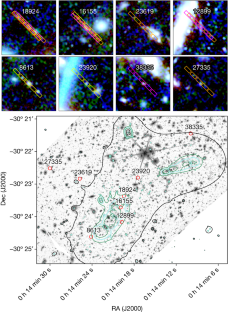2024-02-28 ペンシルベニア州立大学(PennState)
<関連情報>
- https://www.psu.edu/news/research/story/cosmic-lighthouses-cleared-primordial-fog-identified-jwst/
- https://www.nature.com/articles/s41586-024-07043-6
宇宙を再イオン化した光子の大部分は矮小銀河から飛来していた Most of the photons that reionized the Universe came from dwarf galaxies
Hakim Atek,Ivo Labbé,Lukas J. Furtak,Iryna Chemerynska,Seiji Fujimoto,David J. Setton,Tim B. Miller,Pascal Oesch,Rachel Bezanson,Sedona H. Price,Pratika Dayal,Adi Zitrin,Vasily Kokorev,John R. Weaver,Gabriel Brammer,Pieter van Dokkum,Christina C. Williams,Sam E. Cutler,Robert Feldmann,Yoshinobu Fudamoto,Jenny E. Greene,Joel Leja,Michael V. Maseda,Adam Muzzin,… Katherine E. Whitaker
Nature Published:28 February 2024
DOI:https://doi.org/10.1038/s41586-024-07043-6

Abstract
The identification of sources driving cosmic reionization, a major phase transition from neutral hydrogen to ionized plasma around 600–800 Myr after the Big Bang1,2,3, has been a matter of debate4. Some models suggest that high ionizing emissivity and escape fractions (fesc) from quasars support their role in driving cosmic reionization5,6. Others propose that the high fesc values from bright galaxies generate sufficient ionizing radiation to drive this process7. Finally, a few studies suggest that the number density of faint galaxies, when combined with a stellar-mass-dependent model of ionizing efficiency and fesc, can effectively dominate cosmic reionization8,9. However, so far, comprehensive spectroscopic studies of low-mass galaxies have not been done because of their extreme faintness. Here we report an analysis of eight ultra-faint galaxies (in a very small field) during the epoch of reionization with absolute magnitudes between MUV ≈ −17 mag and −15 mag (down to 0.005L⋆ (refs. 10,11)). We find that faint galaxies during the first thousand million years of the Universe produce ionizing photons with log[ξion (Hz erg−1)] = 25.80 ± 0.14, a factor of 4 higher than commonly assumed values12. If this field is representative of the large-scale distribution of faint galaxies, the rate of ionizing photons exceeds that needed for reionization, even for escape fractions of the order of 5%.



